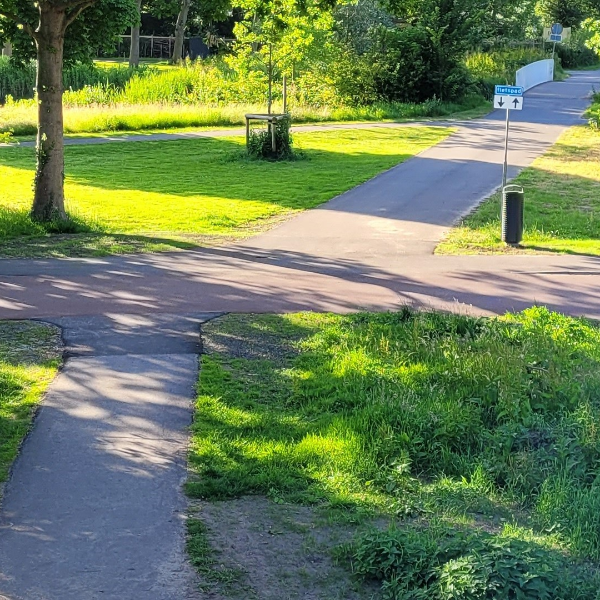Schoterbos Haarlem:
From forest to urban park for everyone

The transition of the Schoterbos Urban Park demonstrates how an existing natural environment in a city can offer even more value to local residents and visitors. The construction of two bicycle through-routes that eliminate the need for cyclists to mix in with motorised traffic has been combined with many expansions that enable young and old to enjoy this unique urban natural environment. The project also devotes attention to biodiversity.
Witteveen+Bos is a partner of the Municipality of Haarlem in transforming a conventional forest to an urban park. In the process leading up to the final design, and in the final design itself, multiple sustainable design principles (SDPs) were applied, such as Nature-based Design, Participatory Design, Trias and Circular Design.
Participatory Design
Participatory Design means not designing for the local community but with the local community. Because of the increased support base and review with stakeholders, implementation will be more efficient and the design will be a better match with the local community’s wishes.
During the second redesign phase, key stakeholders were actively involved. Two participatory meetings were organised as the final design evolved. The first meeting was attended by a select group including representatives from the district, on behalf of nature organisations, the Dutch Cyclists’ Union, as well as local youth.
This was followed by a participatory day. A large tent was installed in the centre of the park in which the key design elements were presented on large posters organised by theme. People from the neighbourhood and other interested parties were encouraged to contribute ideas and express their opinion about the design.
Guided tours through the park on this day brought the new design further to life. The plans were explained at the site itself so that stakeholders, with the proposed design in hand, could see how the new park will be coming to life.
Nature-based Design
The Nature-based Design principle requires the engineer to map out natural processes: physical, chemical and/or biological. During the design it is important to avoid these processes from having any negative effects, and instead use them to create additional benefits.
In the first phase of the transition, the existing water discharge problems in the forest were solved by creating additional surface water. This increases the climate adaptivity of the forest, as well as its surroundings. Indeed, more water means increased cooling.
After the water discharge issue had been dealt with, work was initiated to expand the tree population with native and exotic species. This was done with an educational perspective in mind. Combined with the nearby smallest zoo in the Netherlands, primary schools in the Haarlem region can make use of Schoterbos Park for nature education.
The detailed design also incorporated a focus on biodiversity and ecology. The location of plants and trees is specifically aligned with the approach route of birds and bats. Special fauna exit sites, also known as ‘duck stairs’, were installed to allow animals to move easily or to get out of the water.
Social Design
The Social Design principle means that, as an engineer, you consider how to increase the project’s impact on society by taking a broader view rather than by just focusing on technical measures alone.
One of the main design principles was to connect Schoterbos Park to the existing bicycle network. This was achieved by constructing two bicycle paths. The north-south route in particular provides cyclists with the possibility of moving between central station and Haarlem North in the midst of beautiful nature and little traffic.
The other bicycle path is consistent with the goal of making the park even more accessible for sports, games and recreation. The renovated Schoterbos Park offers children various facilities, such as a climbing rack that naturally rises up from a hill, a maze with mowed paths between the plants, and a football field.
The fishing pier is for young and old. The same thing applies to the fitness equipment and the jogging/rollerblading route set aside on the extra wide cycling/walking paths. Dog lovers have access to an off-leash area that also allows these four-legged friends to take a dip in the water. The renovated Schoterbos Park also has many nice spots for people who want to enjoy nature in tranquillity. In short, the transition has attempted to make the forest attractive for every Haarlem resident and visitor.
Trias
The Trias design principle involves limiting and optimising consumption – and thus the depletion – of energy and raw materials. This also reduces costs during the design’s operational lifespan.
In the run-up to the final design, consideration was also given to reducing the use of raw materials, as well as the possibilities of reusing existing materials. The pond was widened at various locations in the park. Where possible, existing bridges were used as a basis for renovating bridges. Another example here is the renovation of the existing playground elements.
More information?




